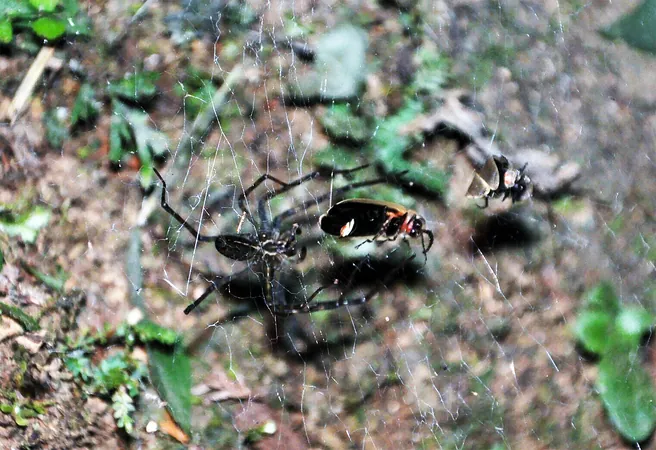
Spiders Outsmart Fireflies: Using Glow as Bait for Dinner!
2025-08-30
Author: William
Spiders Learn to Turn Firefly Glow into Dinner Traps!
Fireflies illuminate the night with their mesmerizing bioluminescence, searching for mates. Now, certain crafty spiders have discovered a brilliant way to exploit these glowing signals as deadly traps for unsuspecting prey.
A fascinating study from Tunghai University in Taiwan, published in the Journal of Animal Ecology, reveals how a species of sheet web spider has adapted to use firefly light to lure in dinner.
Spiders Spin a Deadly Trap with Firefly Light
Researchers observed Psechrus clavis spiders keeping captured fireflies alive in their webs, allowing them to continue glowing for nearly an hour. This behavior suggests that the spiders recognize the value of the fireflies' light as bait.
In a series of experiments, scientists enhanced spider webs with LED lights mimicking the fireflies' glow. The results were astonishing: webs with the faux firefly light attracted three times more prey than those without, and the number of captured fireflies specifically skyrocketed tenfold!
The Illusion of Attraction: How Spiders Outsmart Their Prey
Interestingly, most of the glowing victims were male fireflies, duped by the lights into thinking they had found a mate.
Dr. I-Min Tso, the lead researcher, noted, "This research reveals an unforeseen twist in predator-prey dynamics, showcasing how firefly signals, originally meant for attracting mates, also serve a crucial role in spider survival."
Smart Predators: Adapting for Survival
Psechrus clavis, also known as lace sheet weavers, are found in subtropical forests across East Asia. Their main target, the winter firefly Diaphanes lampyroides, emits a steady glow, making them particularly susceptible to spider tricks.
Video recordings showed the spiders were selective in their approach to different prey. They would quickly consume moths but seemed to savor the prospect of fireflies, delaying their consumption.
According to Dr. Tso, "This behavior indicates that the spider can discern various species, using the bioluminescent signals to fine-tune its approach." This highlights the spiders' adaptability and clever strategies.
The Art of Deception: Survival Tactics of Sit-and-Wait Predators
This groundbreaking study underscores the reliance of sit-and-wait predators on deceptive tactics, which are less energy-consuming than active hunting strategies.
By utilizing the luminous signals from fireflies, P. clavis enhances its deceptive capabilities without needing to produce its own light—similar to deep-sea predators like anglerfish.
A Glowing Example of Predator-Prey Interactions
Conducted in the lush Xitou Nature Education Area, the field experiment allowed researchers to observe these spider-prey interactions in their natural habitat. Although LED lights successfully mimicked firefly glow, the team acknowledged that they couldn't perfectly replicate the complexity of real firefly signals.
The study offers ground-breaking insights into the intricate web of interactions between predators and prey, suggesting that what begins as a romantic signal for fireflies may actually lead them straight into danger.
In the world of nature, signals intended for love can quickly turn into tools for survival—when your predator is a clever spider waiting patiently in its web!
Join the Conversation!
This compelling study is featured in the Journal of Animal Ecology. Subscribe for more captivating articles and stay up-to-date with the latest discoveries in nature!









 Brasil (PT)
Brasil (PT)
 Canada (EN)
Canada (EN)
 Chile (ES)
Chile (ES)
 Česko (CS)
Česko (CS)
 대한민국 (KO)
대한민국 (KO)
 España (ES)
España (ES)
 France (FR)
France (FR)
 Hong Kong (EN)
Hong Kong (EN)
 Italia (IT)
Italia (IT)
 日本 (JA)
日本 (JA)
 Magyarország (HU)
Magyarország (HU)
 Norge (NO)
Norge (NO)
 Polska (PL)
Polska (PL)
 Schweiz (DE)
Schweiz (DE)
 Singapore (EN)
Singapore (EN)
 Sverige (SV)
Sverige (SV)
 Suomi (FI)
Suomi (FI)
 Türkiye (TR)
Türkiye (TR)
 الإمارات العربية المتحدة (AR)
الإمارات العربية المتحدة (AR)